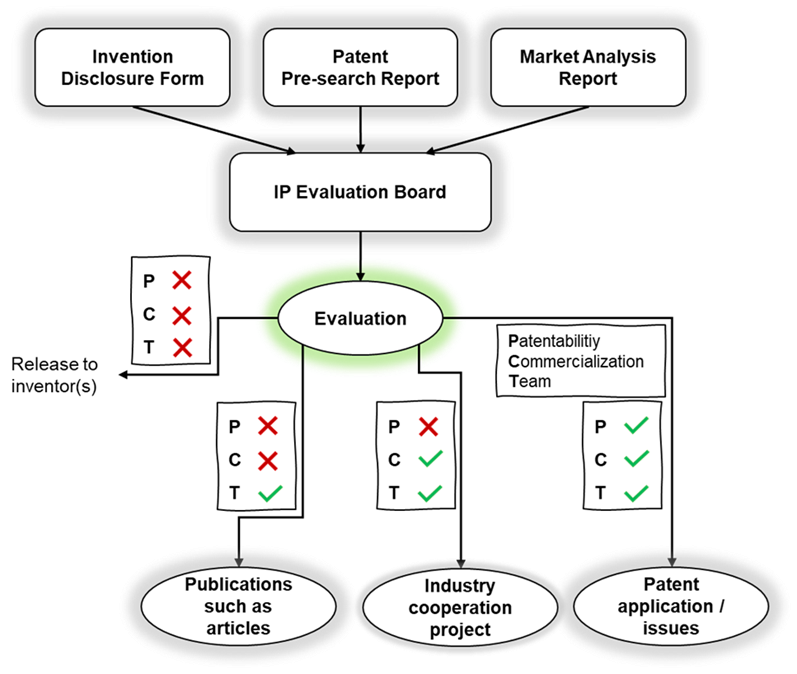Managing University Patent Portfolios: A Smarter Approach to Inventions
In a world where universities generate countless new inventions, the challenge isn’t just creating innovative ideas — it’s deciding which ones to invest in. With limited resources — a natural reality — universities must be strategic in managing their patent portfolios, ensuring they optimize their choices to bring the most promising inventions to market.
The Need for Strategy
Not every invention is destined for commercial success, but that doesn’t mean it should only be abandoned. Instead, universities need a system to guide each patent toward its best path. Some will head toward commercialization, while others may need further research or partnerships with industry. A structured evaluation approach allows universities to make informed decisions, balancing resources and strategic goals.
This approach is further explored in our article, Strategic Portfolio Management of University-Owned Patents for Commercializing Inventions, where we delve into how scoring systems can help universities align their patent management strategies with real-world commercialization potential.
Asking the Right Questions
To guide this process, we ask some key questions about each invention:
- Is it truly new, or just a small step forward?
- Does it solve a real-world problem in a meaningful way?
- Can it be turned into something people will actually use (and pay for)?
- Is the team behind it committed and capable of making it happen?
- Is this a 1001st solution in this technical field, or is it completely/almost unique?
- Does it align with the university’s long-term / mid-term strategic goals?
These questions help universities focus their resources on inventions with the most potential.
How the Evaluation System Works
The evaluation (scoring) system is built around three main criteria: patentability (including novelty and inventive step), commercialization potential, and the team’s commitment. For example, an invention with high novelty but low commercialization potential might be directed toward scientific research rather than immediate market entry. Conversely, an invention with strong market potential and a solid team might head straight toward commercialization.
Each patent is evaluated based on these criteria, ensuring that resources are invested wisely. The system isn’t about rejecting ideas — it’s about finding the right path for each one. Whether it’s commercialization, industry collaboration, or academic publication, the evaluation (scoring) system helps determine where an invention should go.

An example of scoring flow
The Right Path for Every Invention
Not all inventions are created equal, and they don’t all need to follow the same path. After scoring and evaluating an invention, we guide it toward the best route:
- Commercialization: For high-potential inventions ready for the market.
- Industry Partnerships: When collaboration helps bridge gaps in expertise or resources.
- Further Research: Some ideas need more time before they’re ready for commercialization.
- Returning to Inventors: If an invention isn’t market-ready, inventors can continue developing it independently.
This approach ensures no good idea is wasted, and every invention is given its best chance to succeed.
Navigating Costs in a Challenging Economic Climate
In the face of global economic recession, universities must be even more mindful of managing patent portfolios. Patent maintenance and filing costs can quickly add up, so it’s not always necessary to patent every invention. Instead, universities can publish their research to benefit the public, embracing open-source, open communication, and collaborative approaches. In this climate, being open-minded about how knowledge is shared can lead to more valuable societal contributions.
Commercialization: Where It All Comes Together
When an invention is ready for commercialization, it’s not just about filing paperwork and waiting for success. It’s about building the right partnerships and agreements to ensure the invention reaches the market and thrives.
Smart licensing is key. It’s not about just getting a high valuation — it’s about creating a win-win deal for both the university and the company. If the company makes money, so does the university. That’s why structuring smart terms, like flexible royalty rates and carefully timed payment schedules, creates lasting, sustainable success for both the university and the company.
Conclusion: Aligning Innovation with Strategy
Managing a university’s patent portfolio is more than filing patents and hoping for success. It’s about making smart, strategic decisions that align with the university’s resources, goals, and the potential of each invention.
By using a structured evaluation (scoring) system to guide these decisions, universities can ensure that every patent finds its best path forward — whether that’s commercialization, further research, or collaboration with industry partners. The key is to balance innovation with practicality, giving each idea the chance to make a real-world impact.
For further details on how strategic patent portfolio management works, you can read the full article here.
About the authors
 Dr. Muhammed Kasapoğlu holds a PhD in Food Engineering from Yıldız Technical University, where he also completed his master’s in Inorganic Chemistry. Since December 2021, he has been serving as the General Manager of Entertech İstanbul Technopolis. Previously, he was the Manager of the Technology Transfer Office at Yıldız Technopark from 2014 to 2021. His career also includes roles as R&D Manager at Polifarma Pharmaceuticals and R&D Specialist at Abdi İbrahim and Deva Pharmaceuticals Companies.
Dr. Muhammed Kasapoğlu holds a PhD in Food Engineering from Yıldız Technical University, where he also completed his master’s in Inorganic Chemistry. Since December 2021, he has been serving as the General Manager of Entertech İstanbul Technopolis. Previously, he was the Manager of the Technology Transfer Office at Yıldız Technopark from 2014 to 2021. His career also includes roles as R&D Manager at Polifarma Pharmaceuticals and R&D Specialist at Abdi İbrahim and Deva Pharmaceuticals Companies.
 Volkan Okutan graduated in Naval Architecture and Engineering in 2005. He worked as an engineer in shipyards from 2005 to 2011, contributing to the construction of over 10 vessels. He then spent six years in patent offices, managing more than 300 patent documents and various patent granting procedures. From 2017 to 2022, he worked as a technology transfer specialist in university TTOs, managing four patent licensing processes. Since February 2022, he has been the BD Manager at Entertech İstanbul Technopolis. Volkan holds a master’s from Istanbul University Marine Sciences Institute, completed in 2017.
Volkan Okutan graduated in Naval Architecture and Engineering in 2005. He worked as an engineer in shipyards from 2005 to 2011, contributing to the construction of over 10 vessels. He then spent six years in patent offices, managing more than 300 patent documents and various patent granting procedures. From 2017 to 2022, he worked as a technology transfer specialist in university TTOs, managing four patent licensing processes. Since February 2022, he has been the BD Manager at Entertech İstanbul Technopolis. Volkan holds a master’s from Istanbul University Marine Sciences Institute, completed in 2017.



